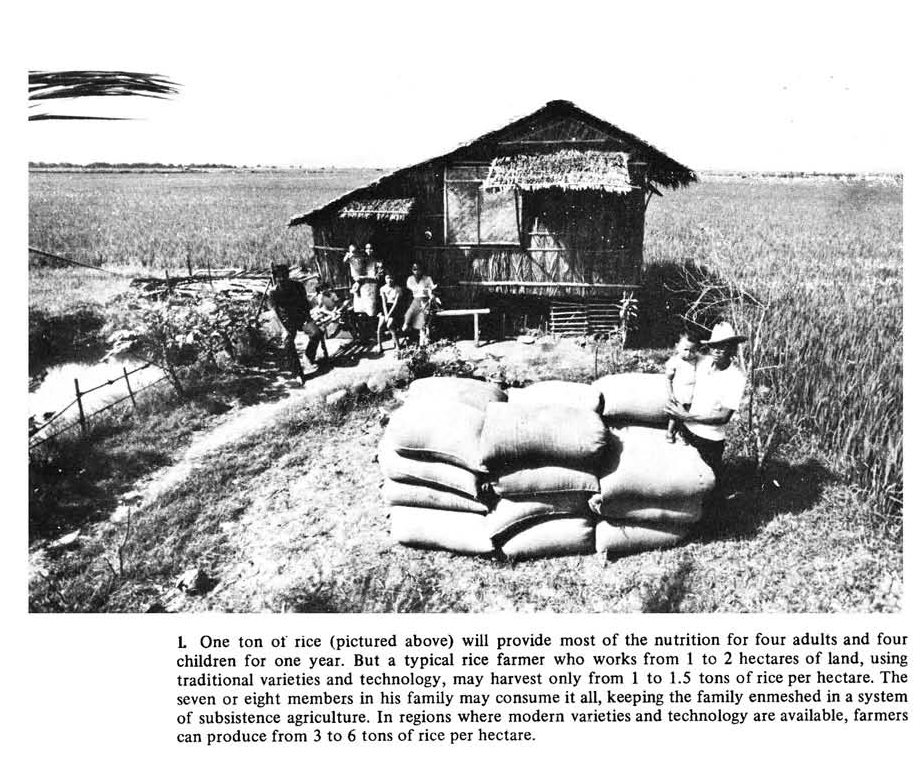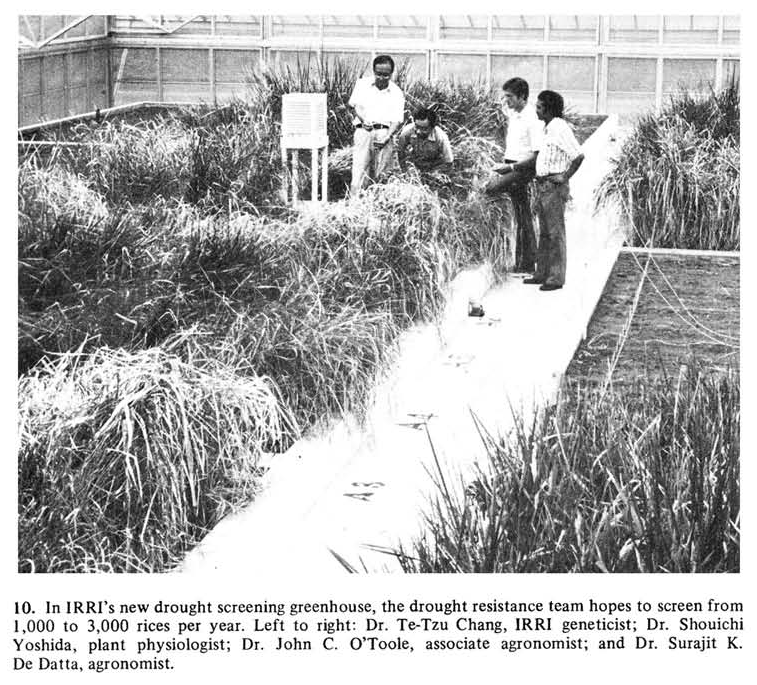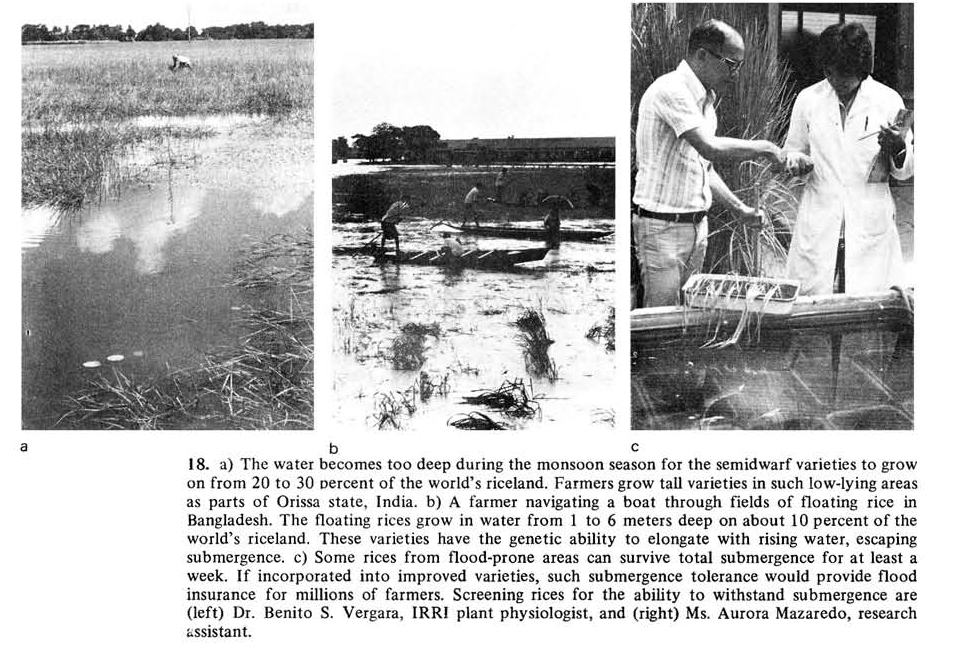We now know that conservatism—the reluctance of farmers to accept new ideas—only partly explains the low adoption of the new rice technology. The primary reason is that the new varieties are out of place in most of the diverse ecological situations under which rice is grown. Fortunately, the marked genetic variability in the world’s rices offers hope that high-yielding varieties can be developed to tolerate the various adverse ecological environments in which rice is grown. We made nearly 4,000 crosses in 1975 to incorporate desirable characteristics, such as disease and insect resistance or drought or flood tolerance, into improved rices. The progeny of crosses, along with accessions from the germplasm bank, were tested around the world and at IRRI by interdisciplinary teams of scientists.
 The new semidwarf tropical rices turn yellow and die in the cold of the mountainous regions, or they are stunted by icy irrigation water from melting snows. In the hottest regions, blazing temperatures render the new rices sterile in the dry season.
The new semidwarf tropical rices turn yellow and die in the cold of the mountainous regions, or they are stunted by icy irrigation water from melting snows. In the hottest regions, blazing temperatures render the new rices sterile in the dry season.
For all of these farmers, the best available technology consists of hardy but low-yielding local varieties and ancient farming methods.
The farmer who typifies the other three-quarters of the world’s rice producers is poor. His entire life and that of his family revolve around his one annual crop of rice. On his 1-hectare farm, he grows from 1 to 1.5 tons of paddy; most is consumed by his family of eight (fig. 1). Population pressure is so intense that what little rice remains will be eaten within 4 or 5 kilometers of the field where it was grown. Chances appear slim that his plight will improve in the near future.
The International Rice Research Institute is increasing its emphasis on the problems of the bypassed farmers. We are screening traditional rices from all over the world to identify those that can withstand particular adverse environments. These rugged varieties will be used as parents in our Genetic Evaluation and Utilization program.
Some donors will contribute the genetic ability to withstand drought. Others have the capacity to elongate with floodwater or to survive submergence: any new rices that will yield better in deep water will need these traits. Centuries of evolution and farmer selection have given us parent varieties that can grow in salty or alkaline soils and still others that can tolerate excessively cold or hot weather.
Our scientists are working with counterparts in the national programs to jointly incorporate the ability to tolerate each of these stresses into a multitude of new rices for farmers in these harsh environments.
But we are not forgetting the fourth of the world’s rice farmers who already grow the modern varieties. We know that the areas under irrigation are increasing, so we are intensifying our efforts to incorporate disease and insect resistance into the semidwarf varieties that respond so well to fertilizer. We are also selecting for varieties that produce high yields at low levels of fertilizer. The eating quality of all these rices is being improved, and their protein content is being increased.
IRRI today faces two giant challenges: to help generate the new rice technology so desperately needed in the bypassed regions, and to push still higher the remarkably high production potential of irrigated rice.
The weather in Asia was favorable in 1975, temporarily alleviating the longterm threat of severe food shortages. The monsoon rains came early and stayed late. Typhoon damage was less severe than normal and the few floods were localized. These favorable conditions permitted modern varieties and associated technology to perform. Even though fertilizer consumption was slightly reduced, most nations produced more rice than in 1974, and several countries reached all-time records.
The 1975 production figures are refreshing and encouraging but they do not alter the long-term expectations of continued food shortages or even famine. One report suggests that by 1985 the food grain shortage in the developing world may be as high as 46 million tons, or six times the quantity of rice that moved in international trade in 1974.
IRRI continued to orient its research to the field problems of the rice farmer during 1975.
We now know that conservatism—the reluctance of farmers to accept new ideas-only partly explains the low adoption of the new rice technology. The primary reason is that the new varieties are out of place in most of the diverse ecological situations under which rice is grown. They are too short for millions of hectares of deepwater areas. Some still lack broad insect and disease resistance and most grow poorly on salty, alkaline, or zinc-deficient soils. They are generally susceptible to damage from excessively cold or hot weather. Few have been specifically bred to tolerate drought or to grow as a dryland crop under upland conditions.
Fortunately, the marked genetic variability in the world’s rices offers hope that high-yielding varieties can be developed to tolerate the various adverse ecological environments in which rice is grown. We are using such rices as parents in our Genetic Evaluation and Utilization program.
The reservoir of rice genetic resources was increased in 1975 as the number of accessions in the IRRI germplasm bank reached about 35,000. IRRI scientists withdrew more than 22,000 samples to use in our breeding programs. We sent an additional 3,347 accessions to collaborating scientists in national research organizations to use in their own programs.
We made nearly 4,000 crosses in 1975 to incorporate desirable characteristics, such as disease and insect resistance or drought or flood tolerance, into improved rices. The progeny of crosses, along with accessions from the germplasm bank, were tested around the world and at IRRI by interdisciplinary teams of scientists. From this gene pool, we identified new sources of resistance or tolerance to the enemies of the rice plant, including brown planthoppers, grassy stunt virus disease, and salinity.
We discontinued the official release of rice varieties during 1975, leaving this responsibility entirely in the hands of scientists in the national organizations. We will concentrate our efforts to feed genetic materials into national programs where local scientists can test and use them as parents to develop newer and better local rices, or as farmer varieties. Two such locally named varieties, IR36 and IR38, were released in early 1976 by the Philippine Seed Board, and others were named in other countries.
The potential to grow two or even three crops annually instead of one has forced greater attention to the development of early-maturing (100-115 days) rices. IR36 matures in about 110 days, is resistant to major insects and diseases, and yields about as well as IRS and comparable varieties. But when yield is calculated in kilograms of grain per day-as it must be in regions where rice can be grown year around-IR36 yields considerably higher than medium-maturing varieties.









